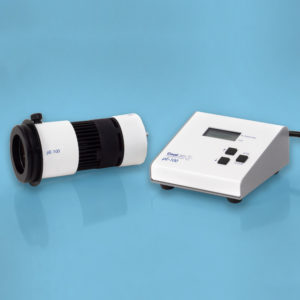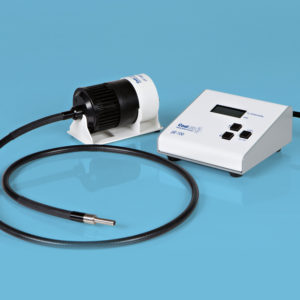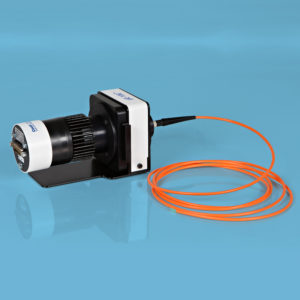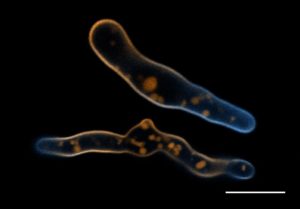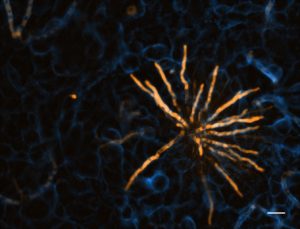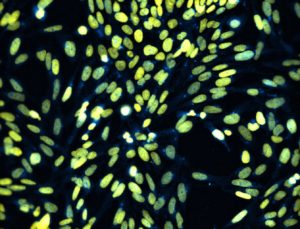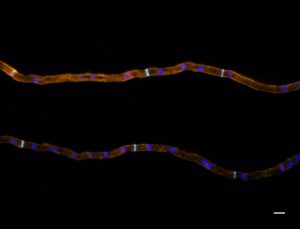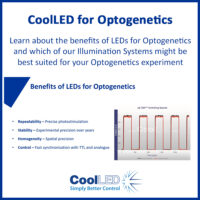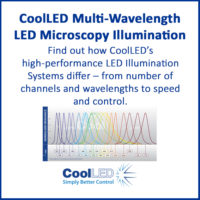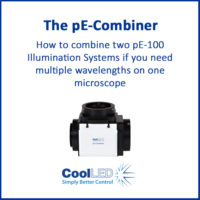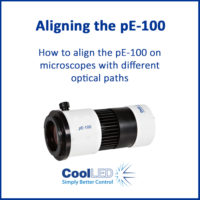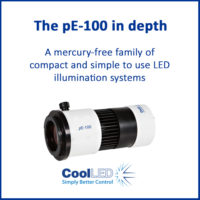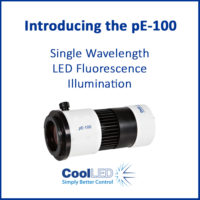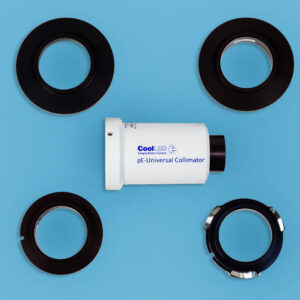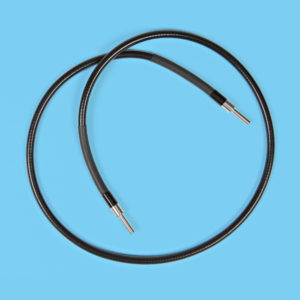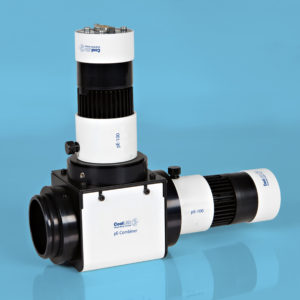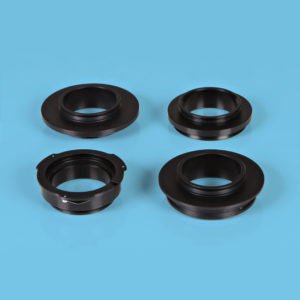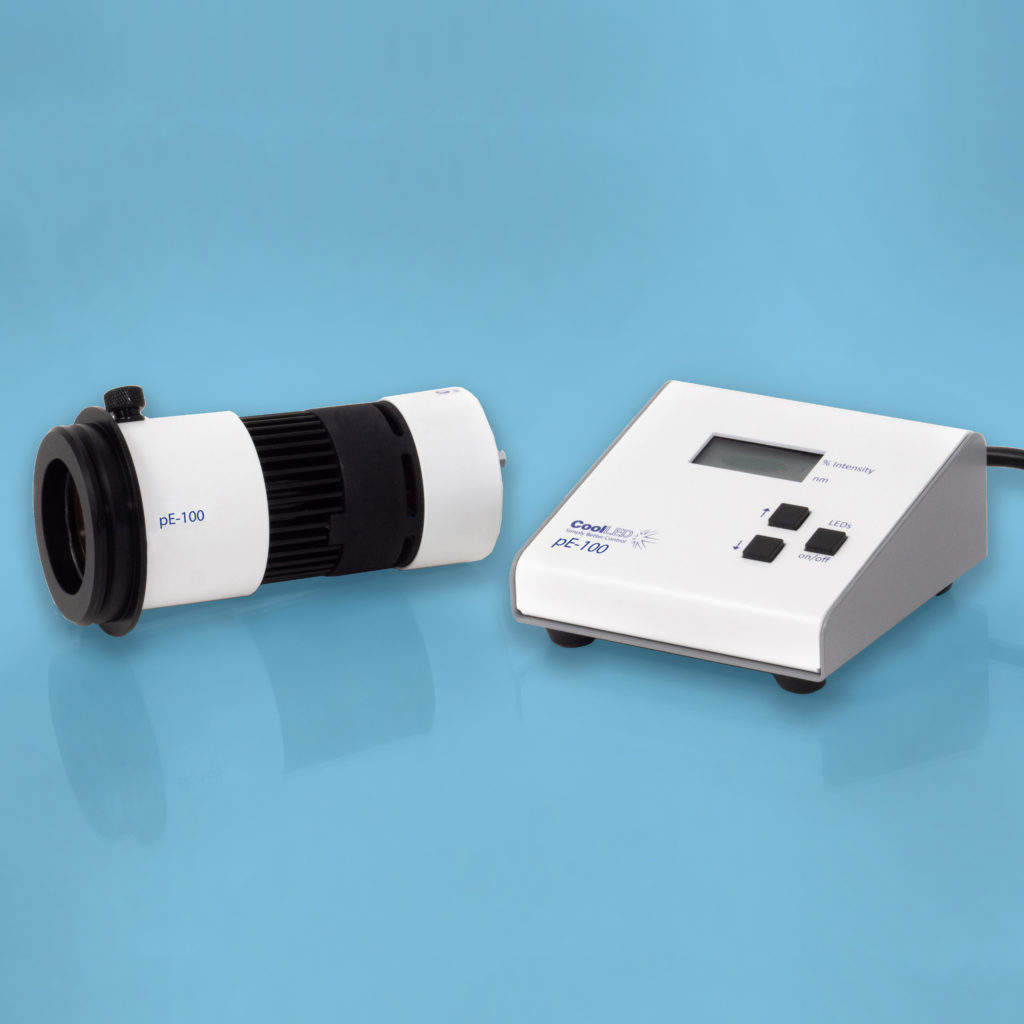
- pE 100fibre back with fibre cable SQ
Overview
The pE-100 series is a family of single-wavelength fluorescence LED illumination systems, which are compact and simple to use. Systems can be specified at any one of 20 different LED wavelengths, and are ideal for routine clinical screening, electrophysiology or basic research applications. Operation is by a remote manual control pod with instant on/off and irradiance control from 0-100%, with remote control available via a TTL trigger.
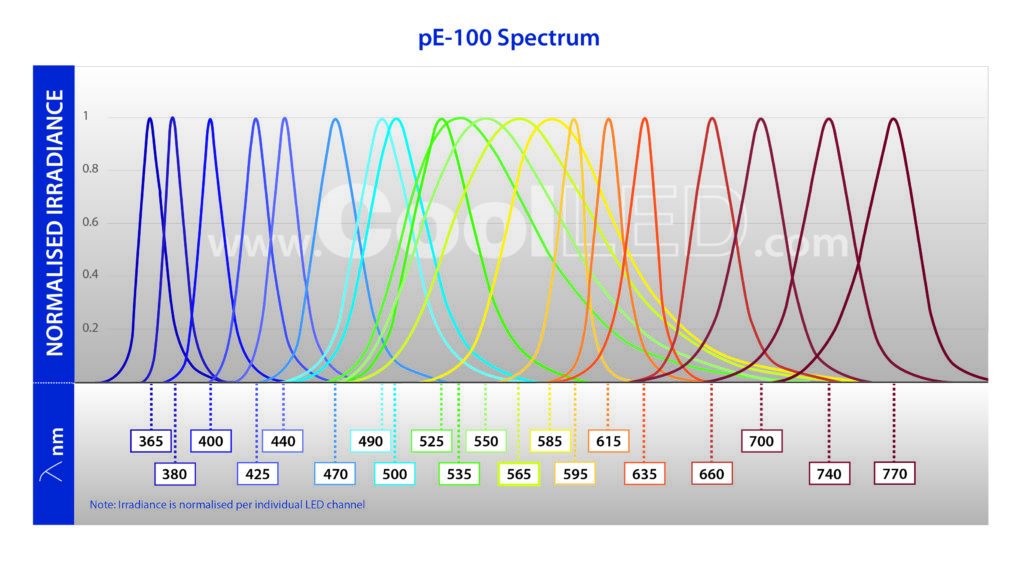
The pE-100 system is designed for fluorescence applications requiring a single LED excitation wavelength. It is perfect for clinical applications such as routine screening (e.g. using Auramine for Tuberculosis), for research applications requiring precise irradiance control and fast-switching, or for electrophysiology applications where light has to be delivered to a specific location. The user can select from 20 different LED wavelengths, ranging from the near-UV at 365 nm to the near-IR at 770 nm. For increased irradiance, a direct fit version is also available, which fits directly to the microscope via a specified adaptor.
- Broadest LED spectrum available: 365-770 nm: replaces metal halide or mercury
- Compatible with existing single and multi-band filter sets: no need to buy new filters
- Simple to fit, simple to use: no alignment, a once only adjustment
- Stable and repeatable: reliable and consistent results
- Wide range of microscope adaptors: fits most microscopes
- Precise irradiance control in 1% steps (0-100%): no ND filters required
- Excellent uniformity over field of view: fixed and stable, no alignment necessary
Plus all the benefits of LED technology.
The system comprises a pE-100 LED Light Source, control pod, and power supply.
Control
Control pod for operation and access to settings and usage history.
Manual:
Manual control for instant on/off and irradiance control in 1% steps from 0 – 100%
Remote:
Via single TTL for on/off control using a BNC connection on the control pod. Triggering speed approx. 150 µs
Choosing configurations
There are three standard pE-100 configuration options:
- Direct-fit: The pE-100 is designed to connect directly to a microscope’s epi-illumination port by selecting from a range of microscope adaptors. A simple once only adjustment will allow optimisation to the optical path of the microscope (watch the tutorial video here).
- Liquid Light Guide: The pE-100light guide connects to the microscope via a fixed 3 mm diameter, 1.5 m long liquid light guide.
- Fibre: The pE-100fibre features an SMA connection for accepting multimode fibres and has been designed with efficient coupling into a wide range of fibre types. The pE-100fibre also includes excitation filter holders.
Combining pE-100 Light Sources
- Direct fit configuration
pE-100 units can be combined using the pE-Combiner for applications requiring a second LED wavelength with independent control and triggering.
Specifications
Power requirements
100-240 V a.c. 50/60 Hz
Power consumption
2.2 W (standby) 25 W (full irradiance)
Dimensions
pE-100 Light Source (direct fit): 60 mm(w) x 170 mm(d) x 70 mm(h) – Weight 0.38 kg
pE-100light guide Light Source: 52 mm(w) x 95 mm(d) x 52 mm(h) – Weight 0.42 kg
pE-100fibre Light Source: 76 mm(w) x 165 mm(d) x 80 mm(h) – Weight 0.42 kg
Combined 2 x pE-100fibre: 190 mm(w) x 220 mm(d) x 190 mm (h) – Weight 1.5 kg
pE-100 Control Pod: 102 mm(w) x 110 mm(d) x 50 mm(h) – Weight 0.55 kg
pE-100 Power Supply: 55 mm(w) x 95 mm(d) x 40 mm(h) – Weight 0.19 kg
Environment and Safety
- Mercury-free and Laser-free
- Energy Efficient
- Long lifetime
- No bulb replacements
- Reduced risk of eye damage
- Quiet operation
- No special disposal regulations or issues
Warranty
Industry-leading 36 months. Read more here.
All data correct at time of publication
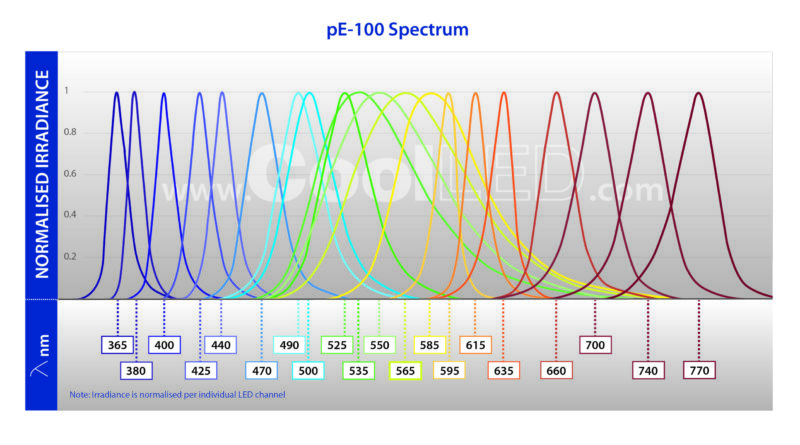
We are often asked about the power, intensity or irradiance of CoolLED Illumination Systems. The answer is not as simple as you might believe from many websites and data sheets, and it can be difficult to compare data from these sources as measuring set ups differ.
Photons are also lost as light travels from the light source to sample plane. The only way to objectively compare light sources is by measuring irradiance at the sample plane. To understand why we use the term irradiance and how to measure and compare light sources with accuracy and precision, download our white paper. Or please contact us if you have further questions.
For performance data, please contact us
Our feedback on using the CoolLED is very positive. We recently purchased the new microscope with the CoolLED system. We replaced our previous microscope which had a Mercury deuterium lamp. In comparison with the old lamp there are many advantages to the CoolLED system. The warm-up time is significantly less. The field remains evenly illuminated even when switching between magnifications and, the system provides an excellent quality of light for taking live photographs of cell cultures. From a Health and Safety perspective, it is much better to have the cooled system than to have the Mercury Deuterium lamp. The lifespan of the LED system should also significantly surpass that of the lamp and, as an LED system, the running costs should be lower than the old lamp system.
Andy Chadder - Head of in-vitro Biosafety - Moredun Scientific (pE-100)
We regularly perform assays which look at both the host and pathogen, where keeping both alive and happy is no mean feat. Luckily, we can employ low-power, fast-trigger excitation LEDs with our pE-Series Illumination Systems to perform live cell imaging, involving calcium signalling, fluorescent anti-microbial peptide dynamics and the fungal/host cell biology therein at high temporal frame rates.
Dr Darren Thomson, Experimental Officer at the Manchester Fungal Infection Group, UoM (pE-100)
CoolLED pE-100 (470 nm) provides very bright and stable excitation light for GCaMP3 imaging. Use of LEDs is very easy and convenient, additionally TTL trigger on and off provides some flexibility.
Chuanqiang Zhang, PhD student, Hans-Berger Department of Neurology, University Hospital Jena (pE-100)
I originally approached various companies with regards to getting an LED light source for my Leica DMLB microscope. The fact that the microscope was old and had a mechanised stage meant that some of the LED systems that we looked at were unsuitable to be fitted. Thankfully the CoolLED system simply slots in where the old mercury bulb unit used to sit. It took less than five minutes to fit, and was ready to use once it was switched on. No more waiting for the bulb to get to temperature, no more bulb changing, or re-calibrating of the mirrors before use. Simply marvellous!
Kam Yim Wong, Immunology Dept, Derriford Hospital, Plymouth UK (pE-100)
We have had great results using the CoolLED pE-100 on our TB, fungus and bacteria screening microscopes and find the CoolLED LED products make screening quick and easy.
Richard Wills, Microbiology Laboratory Manager at The Royal Berkshire Hospital (pE-100)
The main benefit of CoolLED's light source is the ability to switch on and off when required and also not having to align or change a bulb every 300 hours. Over the years it will pay for itself when compared to the cost of mercury bulbs.
Kevin MacKenzie, Histology/EM and Imaging Facility, Institute of Medical Sciences, Aberdeen University (pE-100)
Research Papers
- GABAergic regulation of striatal spiny projection neurons depends upon their activity state
- Heterogeneous receptor expression underlies non-uniform peptidergic modulation of olfaction in Drosophila
- A cortico-collicular circuit for orienting to shelter during escape
- Serotonin in the orbitofrontal cortex enhances cognitive flexibility
- Development of a versatile LCM-Seq method for spatial transcriptomics of fluorescently tagged cholinergic neuron populations
White Papers
| 244-87-XXX-YYY-ZZ: | pE-100 direct fit Light Source, fixed collimating adaptor to customer-specified microscope, remote manual control pod, and power supply. |
| 244-87-XXX-L15-ZZ: | pE-100light guide Light Source with fixed 3 mm diameter, 1.5 m long liquid light guide, remote manual control pod, and power supply. |
| pE-100-F-XXX-ZZ: | pE-100fibre Light Source, remote manual control pod, SMA fibre connection, and power supply (no fibre provided). |
| pE-100-F-XXX-XXX-ZZ: | Combination of two pE-100fibre Light Sources, remote manual control pod, SMA fibre connection, and power supply. Accepts 25 mm diameter excitation filters (fibre and filters not provided). |
Please specify:
- Wavelength (XXX) see Description tab above for wavelength Spectrum.
- Microscope code (YYY) from Adaptors
- Power cable (ZZ): 10 = Australia, 20 = Europe, 30 = UK, 40 = USA
Click here for other accessories.
No imaging software available for this product
